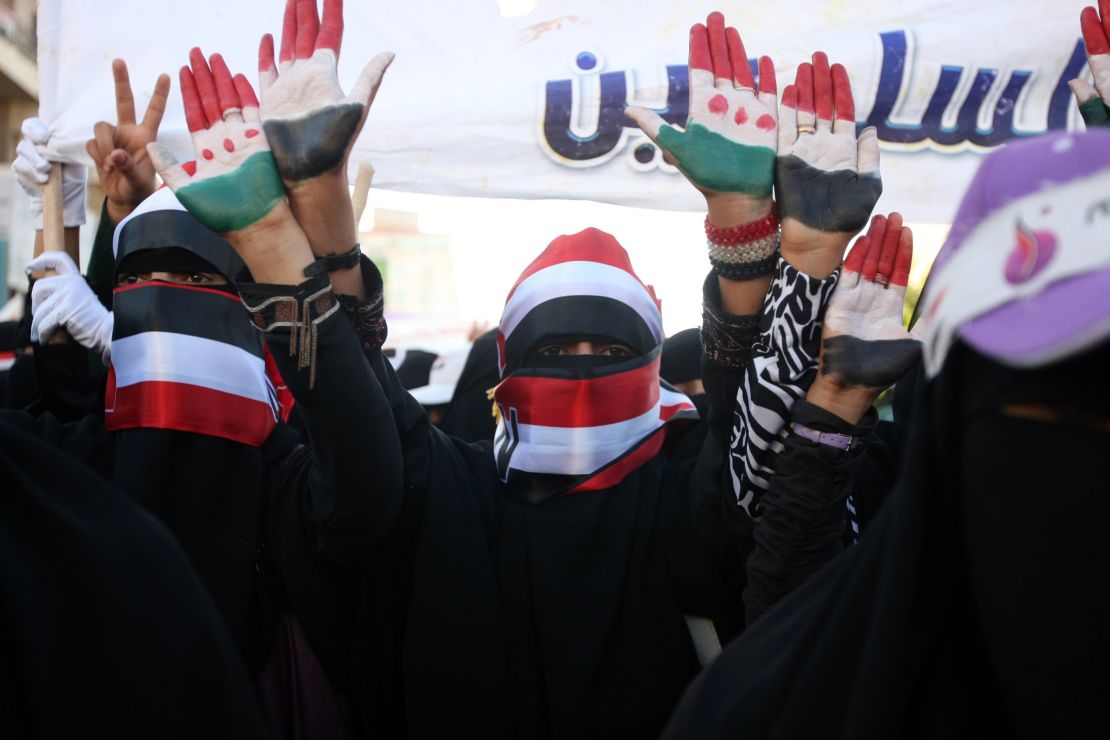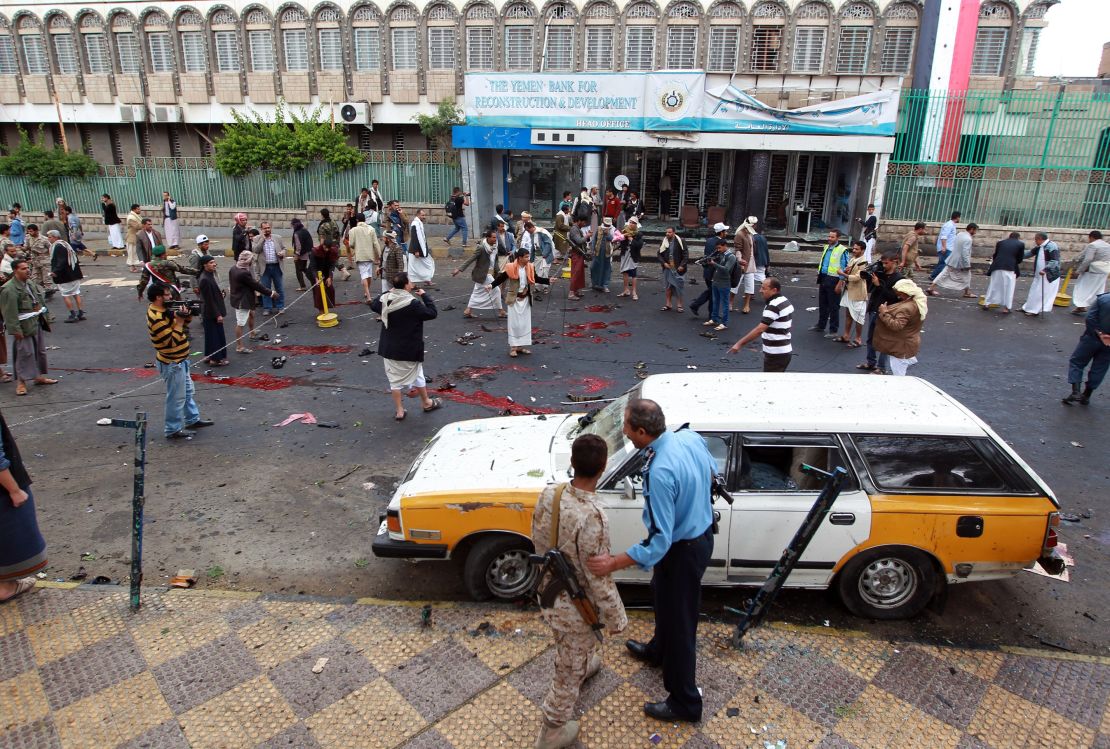Yemen is a fractious, impoverished, weakly governed Middle Eastern nation that has long served as a haven for Islamic terrorists. Now, it appears to be teetering on the brink of all-out conflict. The United Nation’s top adviser on Yemen has warned that the country is moving toward “the edge of civil war.”
The United States recently pulled out its last remaining special forces from the country, a boon for terrorists operating there. And now Saudi Arabia has waded into the complex conflict roiling Yemen.
The unrest has ramifications for the West. Yemen, which U.S. President Barack Obama once cited as a successful example of counterterrorism strategy, is home to al Qaeda in the Arabian Peninsula, considered by U.S. officials to be the most dangerous branch of the terror group.
Here’s a look at the moments that have shaped the current crisis.
A longtime ruler is forced out …

November 23, 2011: After months of protests and violence sparked by the Arab Spring uprisings in other nations in the region, President Ali Abdullah Saleh agrees to relinquish power after more than three decades in office. Saleh, who had been wounded in an attack on his compound earlier in the year, signs a deal to hand over executive powers to Vice President Abdu Rabu Mansour Hadi.
… but a branch of al Qaeda remains strong
April 15, 2014: Despite repeated U.S. drone strikes in Yemen against leaders of al Qaeda in the Arabian Peninsula (AQAP), a video emerges showing what appears to be a large gathering of the terrorist group out in the open. It shows AQAP leader Nasir al-Wuhayshi addressing more than 100 fighters somewhere in Yemen. U.S. officials have said they consider the group to be the most active threat to the homeland.
Shiite rebels move into the capital …
September 9, 2014: Deadly violence flares after weeks of protests in and around the capital, Sanaa, by tens of thousands of Houthis, Shiite Muslims who hold sway in northern Yemen. Protesters clash with security forces at a government building. The Houthis are calling for the government of the Sunni majority country to step down. After the clashes, the rebels intensify their campaign, demanding greater influence and taking control of ministries, state television headquarters and other buildings.
… and the violence spreads

October 9, 2014: The unrest takes on a disturbing sectarian edge as an al Qaeda suicide bombing against a Houthi rally in Sanaa kills dozens of people. A U.N.-brokered ceasefire between the Houthis and the government in September has failed to resolve the crisis. The Houthis are moving into areas of central Yemen and clashing with Sunni tribes who are allied with al Qaeda.
The presidential palace is seized …
January 20 - January 22, 2015: After another ineffective attempt to find a political solution in November, rebels display their hold over Sanaa by storming the presidential palace and forcing the resignations of top officials. President Hadi is kept under house arrest. The move deepens the chaos engulfing the country and sows confusion over who is in charge, alarming the Yemeni government’s allies, notably the United States.
… and foreign governments pull out staff …
February 11, 2015: As the security situation deteriorates, key foreign countries start suspending their embassy operations and pulling their staff out of Yemen. The United States, the United Kingdom and France are the first to announce the move, but others soon follow suit. Political disarray continues as the Houthis announce they will chart Yemen’s political future. The U.N. Security Council, meanwhile, slams the Houthi takeover in Sanaa.
The president flees south
President Hadi escapes from house arrest in Sanaa and flees to the southern province of Aden. He later withdraws his resignation and says all political decisions taken since the Houthis swept into the capital are invalid. Hundreds of thousands of his supporters rally across seven provinces. Lawmakers say his resignation was never accepted by parliament in the first place. He receives the backing of leading Arab governments and the U.N. Security Council.
… and still the violence rages
March 20, 2015: Suicide bombings at two Shiite mosques frequented by Houthis in Sanaa kill at least 137 people. Adding to the complex and confusing situation, ISIS claims responsibility for the attacks. ISIS involvement in Yemen would present not only a new challenge to the Houthis, but also a challenge to ISIS’ rival. Alongside the terrorist violence, forces loyal to the Houthis clash with supporters of Hadi in Aden.
A big question mark looms
March 21, 2015: The United States says it is pulling out its remaining forces in Yemen. It had kept special forces in the country to train Yemeni troops and to be ready to carry out counterterrorism operations. With the American troops gone, what will happen in the fight against AQAP, one of the world’s biggest exporters of terrorism? “We’ll have no intelligence footprint or capabilities to monitor what AQAP and ISIS and the Shia militants are doing in the region,” said Rep. Michael McCaul, chairman of the U.S. House Committee on Homeland Security. “Good intelligence stops plots in the homeland. Without that intelligence, we cannot effectively stop it.”
Saudi Arabia enters the fray
March 26, 2015: Yemen’s neighbor Saudi Arabia begins military operations against the Houthis with support from other Arab nations. Analysts describe the move as an effort to fend off the possibility of a Shiite-controlled Yemen amid concerns over the rising regional influence of Shiite-majority Iran. “We are determined to protect the legitimate government of Yemen,” said Saudi Ambassador to the United States Adel al-Jubeir, referring to Hadi’s administration. The Houthis warned that force will be met with force. “This is a clear aggression and we will respond by a counteraggression,” said Ali Al Imad, a Houthi official.
Saudi military asserts increasing control
March 31, 2015: Almost a week into its military operation, the Saudi-led coalition destroyed air defense systems of the Houthis and supporters of Yemen’s longtime President Ali Abdullah Saleh, and rendered all but a fraction of air bases and air strips unusable, a Saudi source told CNN. Saudi Arabia’s navy gained control of all Yemeni ports, allowing only closely watched non-military medical goods to pass its blockade, according to the source.
Civilian casualties, displaced persons grow, too
End of March 2015: The United Nations reported at least 182 deaths and hundreds more wounded in the fighting. Some 75,000 people have been displaced in the past week, many health facilities shut down and food prices have skyrocketed. Airstrikes that hit the Al-Mazraq camp for displaced persons near Sanaa killed at least 29 people – women and children among them, according to aid group Doctors Without Borders. About 1,100 families live in the camp, said U.N.’s humanitarian affairs coordinator for Yemen, Johannes Van Der Klaauw.
Houthis putting up resistance
April 2, 2015: Houthi commanders said they seized the presidential palace in Aden. President Hadi was last based in the Maasheeq palace before he fled to Riyadh last month. According to a Yemeni security official, Houthis are now in control of most large districts in Aden and there are ongoing clashes.




























